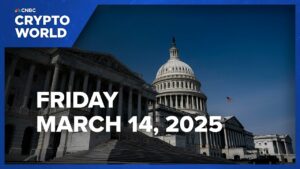Bitcoin reserves and the incentives of the assets of civil assets

Yesterday President Trump announced the long -awaited strategic “Bitcoin” see reserve in terms of truth -social, and many in the room are angry.
First, the reserve seems to be far from Bitcoin. “You make the Charles Hoskinson,” wrote the former columnist of Coindesk Chief Inights, David Z. Morris, about X – Hoskinsons Cardano (ADA), which was included in the reserve. “Cut cancer research to buy Cardano,” another user published.
Others question themselves with possible investment interests in relation to the Trump administration: Trump’s announcement is “a new level of corruption”, wrote the communication strategist Derek Martin and describes David Sack’s investment in Bitwise. “You get the liquidity of the exit liquidity and you will receive starting liquidity. Everyone receives the starting liquidity,” Troy Cross published with a picture of Oprah Bitcoin Policy Institute. (Sacks has now explained that he sold all of his cryptocurrency stocks).
All of these criticisms are common that they completely miss the point. Regardless of whether the reserve consists of additional coins or can serve shameful interests of the administration, for those who hold Bitcoin, there is a low actual consequence.
What is very much of the consequence is how the reserve is financed. On the one hand, many speculate that the United States could redirect tax money to acquire cryptocurrency – a proposal that inevitably would have to go through the congress – which seems unlikely, since Trump gives a new announcement on “investment” today.
Another, much more likely approach, which was already presented in Trump’s executive order by “American leadership in digital financial technology”, is that the reserve “is derived from the Federal Government by its law enforcement efforts of cryptocurrencies.”
That’s okay, you will say because I have preserved all my Bitcoin legally and never and never, and I will never do it to do criminal activities. And that is exactly where they are wrong.
Bitcoin, which is “legally confiscated by the federal government”, does not only include Bitcoin, which is derived from criminal persecution. Bitcoin can also be used by a process called Civil Asset Forfeiture: a funny little game that the government plays in which it does not have to accuse, but has to be accused instead The thing itself of a crime.
Like the Cato Institute in a post in which the reform of the confusion law for civil assets in the New York claim is used in a DUI, the police regularly confiscate cash over 100 US dollars in which there is suspicion that they are used for the purchase of illegal substances. In the most striking example, Cato emphasizes a case from Philadelphia in which the police tried to confiscate the house and car of a grandmother because her son sold marijuana worth less than $ 200 from the house without her knowledge. In Philadelphia alone, civil assets were so amazingly abused that the city confiscated over 1,000 houses, over 3,000 vehicles and over $ 44 million in cash over a period of 11 years.
The problem with the decay of civil assets is that it reverse the burden of proof. Instead of being guilty until it is innocent, it is due to the owner of the financial value that the confiscated property has not been used – or not not intended to use – in a crime. The costs of such legal disputes make the decay of civil assets almost impossible to fight.
While the government might have applied civil law losses on cryptocurrencies that normally stopped from their titles in court documents, such as the US Binance account 188746, it never really had a strategic interest in using it more generally. The Bitcoin would be taken to the government and forfeited, but the government would have to sell it for dollars anyway.
If we take Trump’s executive order to the nominal value, this can now change what gives the government an incentive to further turn civilian wealth losses on Bitcoin.
This is a problem because we can probably trace a lot of Bitcoin to touch a sanction ID, a Darknet market or another suspected illegal activity. The question then becomes: How many hops go back? How many UTXOS do we ignore that it is legitimate that Bitcoin is confiscated from potentially illegal activities on behalf of the government to build up your strategic reserve?
The other problem is that if the government suggests the Bitcoin that you have involved in the facilitating of crimes that Bitcoin may have fully achieved, nothing to do with the alleged criminal activity and do not even have to be aware of – the government can still completely, completely legal, your Bitcoin.
If he takes over Trump’s executive order at Face, it seems that cheering the strategic Bitcoin reserve may not be the most intelligent step until it is clear that the decline in civil assets is not used to promote the reserve. After all, it is a concept that should be reformed and should not be encouraged.
This is a guest contribution by L0LA L33TZ. The expressions expressed are entirely their own and do not necessarily reflect the BTC INC or Bitcoin magazine.





